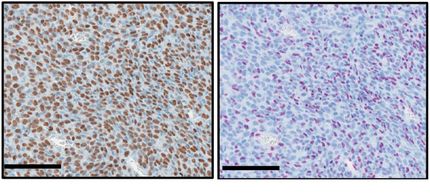Researchers design a tool to induce controlled suicide in human cells
Scientists will use it to analyze the stress responses used by cells to solve genomic errors, and also to identify targets of therapeutic interest
Advertisement
When cells accumulate excessive errors in the proteins they produce, apoptosis is activated, that is to say, a cell suicide programme; however, beforehand the cells attempt to rectify the problem through a number of rescue responses. Scientists know only the general outline of the mechanisms behind cellular "stress responses", the interactions between them and the molecular components involved. Researchers at the Institute for Research in Biomedicine (IRB Barcelona) have designed a new tool to study rescue signalling pathways and cell suicide in depth. A description of this method has been published in the Journal Nucleic acids Research.
"We have developed a strategy to induce controlled mutations in the cell, which allows us to gradually activate several repair systems that are triggered before the cell enters the cell death programme. Using previous methods, the effects on cells are less specific and may lead to parallel responses that hinder analysis of the results", explains the author of the article, Lluís Ribas de Pouplana, ICREA researcher and head of the Gene Translation Laboratory at IRB Barcelona.
Traditional techniques consist of exposing the cells to drug or compounds that affect protein production, thereby creating instability. Renaud Geslain, a researcher in Ribas' group and first author of the article, "had a brilliant idea to reproduce the same effect within the cell, without the help of compounds alien to the cell", recalls Ribas. Geslain manipulated a component of the cellular protein synthesis machinery that causes the production of defective proteins. "In response to the accumulation of misfolded proteins, the cellular alarm systems are switched on and stress responses are activated. Given that this approach affects all the proteins, we obtain all the reactions possible, not only responses that could be exclusive to one or a few affected proteins".
The researchers know which modification they introduce into the protein synthesis system and can measure the cellular responses to the error produced. More serious mutations can trigger cell suicide in less than 48 hours, while less severe ones allow the cell to survive for 5 days. "Thus we can observe the whole spectra of cell responses triggered and measure when they begin and the connections between them. Finally, by means of transcriptomics studies, we can identify new components involved in this process", explains Ribas.
The lab has started to obtain results using this new tool. Analyses indicate that part of the cell response to the accumulation of misfolded proteins is the production of several micro-RNAs, small molecules that regulate gene expression. "We still don't know what they do or what genes they repress but we are discovering very surprising functional connections", notes the IRB Barcelona researcher.
Besides, Ribas continues, "the biological problem that we induce in the cell is directly linked to neurodegenerative diseases such as Alzheimer's, Parkinson's and Huntington's, which are caused by the aggregations of misfolded proteins that cause neuronal death". The tool developed at IRB Barcelona will allow the identification of new components of the response mechanisms to these mutations. In the future, these components may become targets for intervention in these and other diseases.
























































